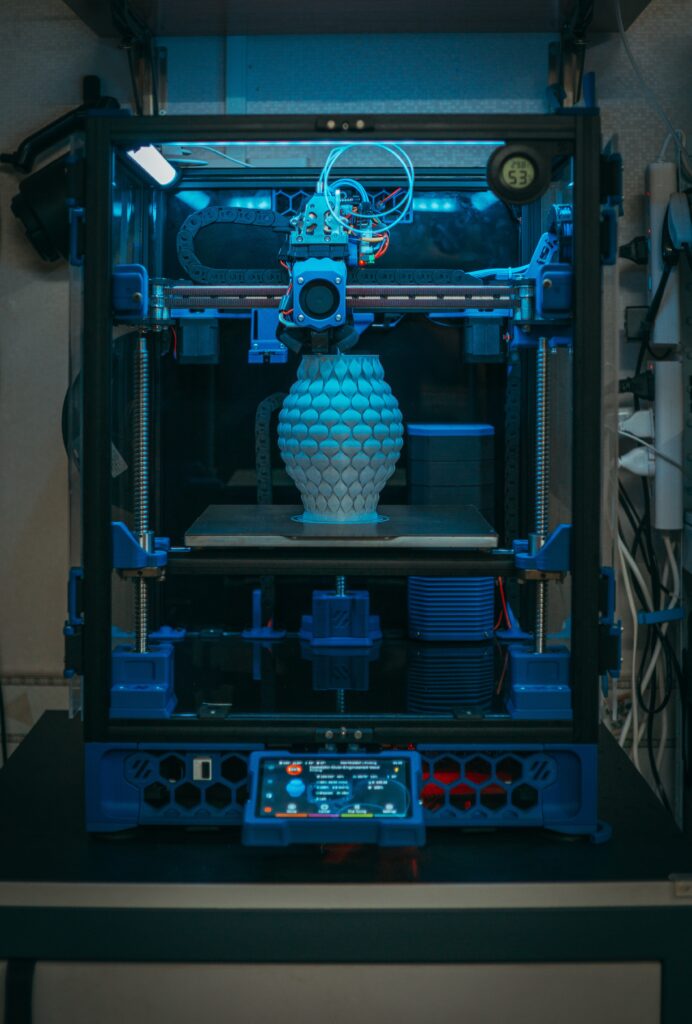Future developments in 3D printing are expected to be both fascinating and revolutionary.
The following are some significant developments in 3D printing:
Expanded Materials:
3D printing is now possible with a variety of materials than just plastics, such as metals, ceramics, composites, and even biological materials. In the future, a greater variety of materials are likely to be 3D printable, creating new opportunities for production across a number of industries.
Speed and Efficiency:
3D printing technology advancements aim to speed up and improve the printing process. It is becoming more realistic for large-scale production as quicker printers with improved resolution and precision are created.
Customization :
One of the biggest benefits of 3D printing is its capacity to produce highly personalized objects. This will continue to be a key area of study, particularly in sectors like healthcare where the need for customized medical implants and prosthetics is great.
Mass Production:
3D printing is gradually transitioning toward mass production, despite its traditional associations with prototyping and small-batch manufacturing. Businesses are looking for ways to expand 3D printing for manufacturing in sectors like aerospace and automotive.
Sustainability:
Due to less material waste produced by 3D printing, it may be more environmentally friendly than conventional production techniques. Future improvements might place more of an emphasis on eco-friendly materials and methods, further strengthening its sustainability.
Bioprinting:
In the medical industry, bioprinting is advancing by printing organs, tissues, and even food. Printing functional organs has the potential to transform transplantation and solve the organ scarcity.
Construction:
By lowering costs and enhancing design flexibility, 3D printing is being utilized to create infrastructure and buildings, potentially changing the sector.
Space exploration:
3D printing is playing an increasingly significant role in this field. It enables the production of tools and parts on-site during journeys to far-off planets and celestial bodies.
Education and Accessibility:
Thanks to inexpensive desktop printers and educational programs, 3D printing is becoming more widely available. This will enable people and students to explore and learn about 3D printing technology.
Regulations and Intellectual Property:
As 3D printing spreads, there will be more issues with regulations and intellectual property rights, notably in the areas of product safety and copyright.
Integration with AI and IoT:
3D printing can enable autonomous and smart manufacturing processes, allowing for more flexible and effective production systems. This is made possible by integrating 3D printing with artificial intelligence (AI) and the Internet of Things (IoT).
3D scanning:
By combining 3D scanning technology with 3D printing, it will be possible to create digital replicas of real-world objects that can be replicated and altered.
To get a better idea of the future of 3D printing, it’s critical to keep track of the most recent advancements and trends in this field. The technology has the potential to upend a number of industries, alter the way goods are created and made, and present fresh answers to challenging issues.
Depending on the use and environment, 3D printing has a number of benefits and drawbacks. The following are some of the main benefits and drawbacks of 3D printing:
Benefits of 3D Printing:
- 3D printing makes it possible to create highly customizable designs and goods, making it perfect for producing one-of-a-kind items like jewelry and prosthetic limbs.
- In order to swiftly iterate and test their designs before going into mass production, designers and engineers can use it as a vital tool for rapid prototyping.
- While 3D printing might be more effective with less material waste than traditional production processes, it can still produce significant material waste.
- 3D printing has the ability to create elaborate and complex designs that are challenging or impossible to make using conventional production techniques.
- Due to the lack of expensive molds or equipment, it can be economical to produce small quantities of goods.
As a result, there is less need for big stockpiles and warehousing because products may be produced on demand. - Many times, 3D printed items can be created so that they can be put together using fewer parts, which lessens the difficulty of the assembly procedure.
- Desktop 3D printers are getting more accessible to consumers, amateurs, and small enterprises by becoming more cost-effective and user-friendly.
Disadvantages of 3D Printing:
- Although the variety of materials that can be printed in 3D is growing, there are still some drawbacks as compared to conventional manufacturing processes, especially in terms of strength and durability.
- For large-scale production, 3D printing can be slower than conventional manufacturing techniques.
- It may be necessary to post-process 3D printed objects to give them a smooth or polished appearance because the surface finish does not always meet expectations.
- The build volume of a 3D printer’s build bed determines the maximum size of items that can be produced. Large objects can need to be printed in several parts and then put together.
- With other manufacturing techniques, like injection molding or CNC machining, it may be possible to achieve a higher level of detail and resolution than what is possible with 3D printing.
- The cost-effectiveness of the procedure can be impacted by the price of some specific 3D printing materials.
- Intellectual property issues are raised by 3D printing since it makes it simpler for people to copy and distribute items that are protected by patents or copyrights.
- It can be difficult to certify and maintain quality control for 3D printed products in particular sectors, like healthcare and aerospace, where they must adhere to tight regulatory standards.
- The amount of time and money spent on production can increase if 3D printed parts need to be assembled, painted, or sanded after printing, depending on the application.
It’s crucial to take into account these benefits and drawbacks in the context of the particular application and specifications. When utilized properly, 3D printing may be a powerful tool, Nevertheless, it might not always be the ideal option for all manufacturing or design requirements.

